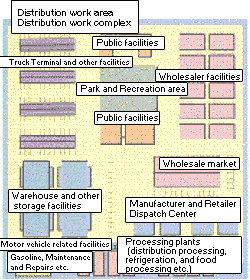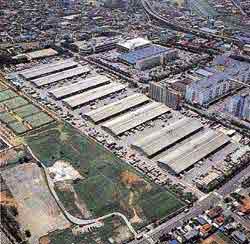| 5.
Distribution 1) In the field of corporate distribution, the industrial and corporate composition of Japan has undergone change due to the intensification of market competition through the advancement of globalization and the IT revolution. As is evident in the switch to supply chain management (SCM)9, for example, from the optimization of the limited sphere conventional system, there is a stronger orientation toward optimization in a wider sphere. Furthermore, distribution outsourcing over a wider area than was the norm in the past continues to increase with a larger role played by distributors such as the proposal-type third party logistic (3PL)10 distributors is expected. These trends bring with them the demand for the realization of a type of distribution system that is information-intensified and has a shorter lead-time over all. In the field of consumer distribution, behaviour patterns of consumers have occurred due to the development of computerization, the diversification and individualization of citizen lifestyles as well as the advancement of a reduced birthrate. Simultaneously, this field has been supported by the development of small volume goods distribution system in Japan and the spread of e-commerce. With such trends present, there is now a demand for the construction of an environment, which encourages the creation, and spread of new distribution services that answer user needs. In addition, as the limitations of natural resources and of nature's self-cleansing power become more apparent, the establishment of a main line distribution system that does not burden the environment and one which is effective in supporting a recycling-oriented society will become necessary. Furthermore, as response to environmental issues continues to increase, the issue of counter measures against NOx and PM gas emissions from trucks is both unavoidable and vitally important. Above all, regarding regional distribution, while trucks are an indispensable mode of transport, the issues of making such transport more efficient and establishing effective measures are the most pressing. Additionally, in order to respond to the labor shortage of young workers due to the problem of reduced birthrate, the establishment of environments that are easier to work in for elderly people and women is a necessity. To answer these needs in a precise way, efforts need to be made to speed up the entire distribution system. This can be done by: enhancing the mutual tie-ups and connections between citizens and bureaucrats as well as between the relative administrative agencies; standardizing, computerizing and energy saving the various activities involved in distribution; developing and implementing new technology; reviewing distributions systems such as those related to import/export systems and nurturing proposal-type distributors. |
| 2)
In terms of inner-region distribution, it is essential that measures related
to trucks and the NOx and PM gas emissions are undertaken. Additionally,
the improvement of loading efficiency of trucks through the enhancement
of high-frequency, small load transport and the use of IT at the same
time as working on the elimination of passing traffic in city centers
through appropriate placement of distribution bases and the construction
of loop roads. Furthermore, in order to realize the lowering of distribution
costs through improved cargo efficiency, the issues of measures that stimulate
an intermodal palletization through the strengthening of pallet pool systems
and the concretization of cargo charges incurred in transport by truck
as well as with regards to further construction of truck bays and unloading
docks. Regarding region-to-region distribution, strategic facilitation of modal shift by assessing the transport and cargo matching the level of use of rail and sea transport is necessary in order to respond to environmental issues. For this reason, improvements in the overhead loading method11 at rail cargo stations as well as a "Rebirth of sea transportation" through the establishment of ocean ITS14 and sea highway network13, the technological development and implementation of high speed ships and Super Eco-ships12 need to be undertaken. Additionally, improvements need to be made in the economical efficiency and delivery of rail and sea transport. At the same time, it is essential that loading efficiency improvements be facilitated in trucks through the use of IT. |
Construction Image of a Wide Area Distribution Base
|
|||
 |
||||
 |
||||
| Northern Distribution Work Area (Adachi ward, Tokyo) |
|
|
PREVIOUS |
|
TOP |
|